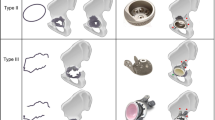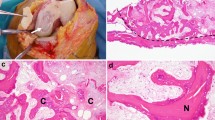Abstract
Introduction
There is significant recent interest in femoroacetabular impingement (FAI) in orthopaedics. The etiology of the cam deformity is unknown but has been hypothesized to be due to stresses from sporting activities in our modern society. Few archeological studies exist of femora and FAI. This study reviewed proximal femoral anatomy in a skeletal collection from the ancient Nile valley archeological site at Tombos 1400-656 BC.
Methods
Digital photographs of the femora were used to obtain angular measurements of the apparent neck shaft, true neck shaft, version, inclination, and α and β angles of Nötzli. All photographs were reviewed by two orthopaedic surgeons for cam and pincer lesions. Sex and age of the specimens was determined when possible. A cam lesion was defined as any femur demonstrating an α angle > 50° or when a cam deformity was seen on visual inspection by both orthopaedic surgeons. Pincer lesions were identified upon visual inspection by both orthopaedic surgeons, when the femoral neck demonstrated impaction lesions, as pelvis radiographs could not be obtained.
Results
There were 126 unique femora; 69 female and 57 male. Age estimates were possible in 100 and was 15–24 years in 14, 25–34 years in 33, 35–49 years in 28, 50–69 years in 17, and ≥ 70 years in 8. There were nine femora (seven individuals) with cam lesions (7%) and five femora (four individuals) with pincer lesions (4%). One demonstrated a combined lesion.
Conclusion
FAI existed in ancient Nile valley inhabitants and is thus not only a product of modern day life style athletics. This contrasts with Native Americans living in Ohio 700–1000 AD where no FAI was identified. This difference is likely due to combinations of different types of activity, diet, and genetics. Further research of ancient populations is needed to further answer this question.
Level of evidence
IV—cohort study.





Similar content being viewed by others
References
Agricola R, Heijboer MP, Ginai AZ, Roels P, Zadpoor AA, Verhaar JAN et al (2014) A cam deformity is gradually acquired during skeletal maturation in adolescent and young male soccer players. A prospective study with minimum 2-year follow-up. Am J Sports Med 42:798–806. https://doi.org/10.1177/0363546514524364
Boldsen JL, Milner GR, Konigsberg LW (2002) Transition analysis: a new method for estimating age from skeletons. In: Hoppa RD, Vaupel JW (eds) Book. Cambridge University Press, Cambridge
Buikstra J, Ubelaker D (1994) Standards for data collection from human skeletal remains. Arkansas Archaelological Survey, Fayetteville
Buzon MR (2006) Health of the non-elites at Tombos: nutritional and disease stress in New Kingdom Nubia. Am J Phys Anthrop 130:26–37. https://doi.org/10.1002/ajpa.20303
Buzon MR, Judd MA (2008) Investigating health at Kerma: sacrificial versus nonsacrificial individuals. Am J Phys Anthrop 136:93–99
Buzon MR, Richman R (2007) Traumatic injuries and imperialism: the effct of Egyptian colonial strategies at Tombos in Upper Nubia. Am J Phys Anthrop 133:783–791. https://doi.org/10.1002/ajpa.20585
Buzon MR, Simonetti A (2013) Strontium isotope (87Sr/86Sr) variability in the Nile valley: identifying residential mobility during ancient Egyptian and Nubian sociopolitical changes in the New Kingdom and Napatan periods. Am J Phys Anthrop 151:1–9. https://doi.org/10.1002/ajpa.22235
Caldarini C, Catalano P, Piccioli A, Spinelli MS, Zavaroni F (2015) Study and data description. In: Picciola A, Gazzaniga V, Catalano P (eds) Book, vol 2. Springer, Cham, pp 39–47
Carsen S, Moroz PJ, Rakhra K, Ward LM, Dunlap H, Hay JA et al (2014) The Otto Aufranc Award. On the etiology of the cam deformity: a cross-sectional pediatric MRI study. Clin Orthop Rel Res 472:430–436. https://doi.org/10.1007/s11999-013-2990-y
Dickenson EJ, Wall PDH, Hutchinson CE, Griffin DR (2019) The prevalence of cam hip morphology in a general population sample. Osteoarthritis Cartilage 27:444–448. https://doi.org/10.1016/j.joca.2018.09.019
Gibbon VE, Buzon MR (2018) A diachronic examination of biomechanical changes in skeletal remains from Tombos in ancient Nubia. HOMO J Compar Hum Biol 69:158–166. https://doi.org/10.1016/j.jchb.2018.07.005
Gibbon VE, Buzon MR (2016) Morphometric assessment of the appendicular skeleton in the New Kingdom and Napatan components from Tombos in upper Nubia. Int J Osteoarchaeol 26:324–336. https://doi.org/10.1002/oa.2424
Hack K, Primio GD, Rakhra K, Beaulé PE (2010) Prevalence of cam-type femoracetabular impingement morphology in asymptomatic volunteers. J Bone Joint Surg [Am] 92-A:2436–2444. https://doi.org/10.2106/JBJS.J.01280
Hogervorst T, Bouma HW, de Vos J (2009) Evolution of the hip and pelvis. Acta Orthop 80S336:1–39. https://doi.org/10.1080/17453690610046620
Joo JH, Lee SC, Ahn HS, Park JS, Lee WJ, Jung KA (2013) Evaluation of the alpha angle in asymptomatic adult hip joints: analysis of 994 hips. Hip Int 23:395–399. https://doi.org/10.5301/hipint.5000036
Kappleman J (1988) Morphology and locomotor adaptations of the bovid femur in relation to habitat. J Morphol 198:119–130
Kingsley PC, Olmsted KL (1948) A study to determine the angle of anteversion of the neck of the femur. J Bone Joint Surg [Am] 30-A:745–751
Koo TK, Li MY (2016) A guideline of selecting and reporting intraclass correlation coefficients for reliability research. J Chirop Med 15:155–163. https://doi.org/10.1016/j.jcm.2016.02.012
Liu RW, Armstrong DG, Levine AD, Gilmore A, Thompson GH, Cooperman DR (2013) An anatomic study of the epiphyseal tubercle and its importance in the pathogenesis of slipped capital femoral epiphysis. J Bone Joint Surg [Am] 95-A:e34(31)-e34(38). https://doi.org/10.2106/L.00474
Lovejoy CO, Heiple KG (1981) The analysis of fractures in skeletal populations with an example from the Libben site, Ottowa County, Ohio. Am J Phys Anthrop 55:529–541
Mastel MS, El-Bakoury A, Parkar A, Sharma R, Johnston KD (2021) Outcomes of femoral de-rotation osteotomy for treatment of femoroacetabular impingement in adults with decreased femoral anteversion. J Hip Preserv Surg 7:755–763. https://doi.org/10.1093/jhps/hnab031
Moats AR, Badrinath R, Spurlock LB, Cooperman D (2015) The antiquity of the cam deformity. A comparison of proximal femoral morphology between early and modern humans. J Bone Joint Surg [Am] 97-A:1297–1304. https://doi.org/10.2106/JBJS.0.00169
Moreno-Mayar JV, Potter BA, Vinner L, Steinrücken M, Rasmussen S, Terhorst J et al (2018) Terminal Pleistocene Alaskan genome reveals first founding population of Native Americans. Nature 553:203–208. https://doi.org/10.1038/nature25173
Moreno-Mayar JV, Vinner L, Damgaard PdB, Cdl F, Chan J, Spence JP et al (2018) Early human dispersals within the Americas. Science 362:1–11. https://doi.org/10.1126/science.aav2621
Morris WZ, Li RT, Liu RW, Salata MJ, Voos JE (2018) Origin of cam morphology in femoroacetabular impingement. Am J Sports Med 46:478–486. https://doi.org/10.1177/0363546517697689
Morris WZ, Weinberg DS, Gebhart JJ, Cooperman DR, Liu RW (2016) Capital femoral growth plate extension predicts cam morphology in a longitudinal radiographic study. J Bone Joint Surg [Am] 98-A:805–812
Musielak BJ, Kubicka AM, Woźniak Ł, Jóźwiak M, Liu RW (2021) Is cam morphology found in ancient and medieval populations in addition to modern populations? Clin Orthop Rel Res 479:1830–1838. https://doi.org/10.1097/CORR.0000000000001771
Ng VT, Ellis TJ (2011) More than just a bump: cam-type femoracetabular impingement and the evolution of the femoral neck. Hip Int 21:1–8
Nötzli HP, Wyss TF, Stoecklin CH, Schmid MR, Treiber K, Hodler J (2002) The contour of the femoral head-neck junction as a predictor for the risk of anterior impingement. J Bone Joint Surg [Br] 85-B:556–560
Novais EN, Maranho DA, Kim Y-J, Kiapour A (2018) Age- and sex-specific morphologic variations of capital femoral epiphysis growth in children and adolescents without hip disorders. Orthop J Sports Med 6:2325967118781579. https://doi.org/10.1177/2325967118781579
Parvizi J, Leunig M, Ganz R (2007) Femoracetabular impingement. JAAOS 15:561–570
Schrader SA, Buzon MR (2017) Everyday life after collapse: a bioarchaeological examination of entheseal change and accidental injury in postcolonial Nubia. Bioarcheology Int 1:19–34. https://doi.org/10.5744/bi.2017.1000
Seijas R, Pérez A, Barastegui D, Revilla E, Celis CLd, Català J (2021) The natural history of alpha angle in the last seventeen centuries. Arch Orthop Trauma Surg. https://doi.org/10.1007/s00402-021-04268-2 (online ahead of print)
Shrout PE, Fleiss JL (1979) Intraclass correlations: uses in assessing rater reliability. Psych Bull 86:420–428
Siebenrock KA, Kaschka I, Frauchiger L, Werlen S, Schwab JM (2013) Prevalence of cam-type deformity and hip pain in elite ice hockey players before and after the end of growth. Am J Sports Med 41:2308–2313. https://doi.org/10.1177/0363546513497564
Toogood PA, Skalak A, Cooperman DR (2009) Proximal femoral anatomy in the normal human population. Clin Orthop Rel Res 467:876–885
Unnanuntana A, Toogood P, Hart D, Cooperman D, Grant RE (2010) Evaluation of proximal femoral geometry using digital radiographs. J Orthop Res 28:1399–1404. https://doi.org/10.1002/jor.21119
Westermann RW, Scott EJ, Schaver AL, Schneider A, Glass NA, Levy SM et al (2021) Activity level and sport type in adolescents correlate with the development of cam morphology. JBJS Open Access 6:e21.00059 (00051-00010). https://doi.org/10.2106/JBJS.OA.21.00059
Westermann RW, Willey MC (2021) Femoral version in hip arthroscopy: does it matter? Sports Med Arthrosc Rev 29:28–34
Zadpoor AA (2015) Etiology of femoroacetabular impingement in athletes: a review of recent findings. Sports Med 45:1097–1106. https://doi.org/10.1007/s40279-015-0339-2
Zurmühle CA, Milella M, Steppacher SD, Hanke MS, Albers CE, Tannast M (2017) ArtiFacts: Femoracetabular impingement—a new pathology? Clin Orthop Rel Res 475:973–990. https://doi.org/10.1007/s11999-017-5270-4
Acknowledgements
The modern community of Tombos welcomed the archaeological team and assisted with excavations each season. The Department of Anthropology at Purdue University provided the curation facilities for the specimens in this study.
Funding
Excavations at the Tombos site were primarily funded by the National Science Foundation (Grants BCS-0917824, 0907815, 0313247) and the National Geographic Society.
Author information
Authors and Affiliations
Contributions
SNC: methodology, investigation, data curation, writing—original draft, writing—review and editing. KEY: data curation, investigation, formal analysis, writing—original draft, writing—review and editing. WMM: data curation, investigation, writing—review and editing. RB: data curation, investigation, writing—review and editing. MRB: grant funding, resources, methodology, data curation, writing—original draft, writing—review and editing, project administration. DC: conceptualization, methodology, investigation, writing—original draft, writing—review and editing, project administration. RTL: conceptualization, methodology, investigation, data curation, formal analysis, writing—original draft, writing—review and editing, project administration.
Corresponding author
Ethics declarations
Conflict of interest
The authors declare that they have no conflicts of interest.
Ethical approval
The Sudanese National Corporation for Antiquities and Museums permitted the excavation and exportation of human remains.
Informed consent
The specimens studied are from 3000 years ago making informed consent impossible, and Institutional Board Review approval does not apply as per Purdue University, curator of the specimens.
Additional information
Publisher's Note
Springer Nature remains neutral with regard to jurisdictional claims in published maps and institutional affiliations.
Rights and permissions
Springer Nature or its licensor holds exclusive rights to this article under a publishing agreement with the author(s) or other rightsholder(s); author self-archiving of the accepted manuscript version of this article is solely governed by the terms of such publishing agreement and applicable law.
About this article
Cite this article
Coon, S.N., Yu, K.E., McLaughlin, W.M. et al. Femoroacetabular impingement in ancient Nubia 1400-656 BC. Arch Orthop Trauma Surg 143, 3909–3917 (2023). https://doi.org/10.1007/s00402-022-04649-1
Received:
Accepted:
Published:
Issue Date:
DOI: https://doi.org/10.1007/s00402-022-04649-1




